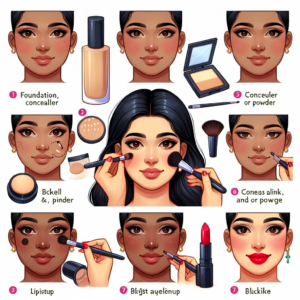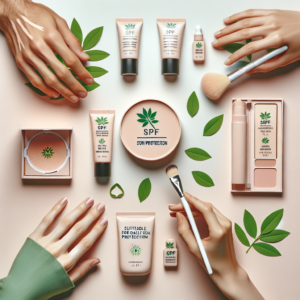
Key Takeaways
- Hypoallergenic vegan SPF makeup is a gentle choice for sensitive skin, minimizing irritation while protecting from the sun.
- Start with a gentle cleanser and moisturizer to prepare your skin for makeup application.
- Apply foundation with soft tools or fingers in a patting motion to avoid skin irritation.
- Look for makeup with the ‘hypoallergenic’ label and understand what ingredients to avoid.
- Choose products with both UVA and UVB protection for comprehensive sun care.
| Product Type | Key Ingredients | SPF Level | Suitable for Skin Type | Notes |
|---|---|---|---|---|
| Foundation | Zinc oxide, Titanium dioxide | SPF 30+ | All, especially sensitive | Mineral-based for gentle coverage |
| Concealer | Aloe vera, Chamomile | SPF 20+ | All, particularly dry | Designed for spot coverage; gentle on delicate areas |
| Tinted Moisturizer | Green tea extract, Vitamins | SPF 30+ | Combination, Normal | Lightweight hydration with sun protection |
| Mineral Powder | Mica, Iron oxides | SPF 15+ | Oily, Acne-prone | Good for touch-ups; helps control shine |
| Lip Balm/Lipstick | Natural oils and butters | SPF 10+ | All, especially dry | Provides hydration and color; gentle on lips |
| Setting Spray | Hyaluronic acid, Rose water | SPF 20+ | All | Sets makeup; hydrating ingredients for skin health |
Before the Makeup: Prepping Your Sensitive Skin
Think of your skin as a delicate canvas – it needs to be treated with care, especially when you’re dealing with sensitivity. Before you even think about makeup, your skin requires a foundation of its own: a good cleansing and moisturizing routine. This isn’t just about cleanliness; it’s about creating a barrier that protects your skin and makes sure the makeup glides on smoothly.
Gentle Cleansing: The Foundation of Flawless Application
When you have sensitive skin, every touch matters. The first step in your routine should be a gentle, fragrance-free cleanser. It should be as mild as a whisper, yet effective – lifting away dirt without stripping your skin of its natural oils. Use lukewarm water and pat your skin dry with a soft towel, resisting any urge to rub.
Moisturizing Tips: Locking in Hydration for Smooth Canvas
Next, while your skin is still slightly damp, apply a hypoallergenic moisturizer. This locks in moisture and creates a smooth base for your makeup. Choose a product that’s free from common irritants like alcohol, dyes, and fragrances. If you’re planning to be out in the sun, make sure your moisturizer has SPF protection as well.
Mastering the Application of Vegan SPF Makeup
Now, let’s talk about the star of the show: hypoallergenic vegan SPF makeup. This isn’t just makeup; it’s your shield against the sun’s rays and the world’s pollutants, all while being kind to your skin and our furry friends.
Step-by-Step Guide: Applying Foundation Without Irritation
When applying foundation, the goal is to enhance, not to hide who you are. Use a soft brush or a clean sponge – or even your fingertips – to gently pat the foundation onto your skin. Start from the center of your face and work your way outwards. Remember, less is more. You’re aiming for a natural look that says ‘I woke up like this.’
Concealer Tricks: Hiding Blemishes with Care
For those pesky spots or under-eye circles, a concealer is your best friend. But use a light hand; dab it on gently with a small brush or your ring finger. The ring finger is the weakest and therefore the gentlest on delicate areas like under your eyes.
Sun Protection Simplified: Ensuring Adequate SPF Coverage
Sun protection is non-negotiable, no matter the weather. Opt for a makeup foundation or a tinted moisturizer with SPF of at least 30. And remember, reapplication is key, especially if you’re spending the day outdoors. A mineral powder with SPF can be a great touch-up solution that doesn’t disturb your makeup.
Why This Makeup is a Game-Changer for Sensitive Skin
For those of us with sensitive skin, finding makeup that doesn’t cause a reaction can feel like a never-ending quest. Hypoallergenic vegan SPF makeup changes the game. It’s designed to be kind to your skin, with natural ingredients that won’t cause irritation. Plus, it protects your skin from the sun’s harmful rays without the use of chemical filters that can cause flare-ups. It’s the triple threat of makeup: gentle, protective, and conscious.
Decoding the ‘Hypoallergenic’ Label for Your Peace of Mind
The term ‘hypoallergenic’ can be a beacon of hope, but it’s important to understand what it really means. It implies that the product is less likely to cause an allergic reaction, but it’s not a guarantee. Therefore, it’s essential to know your own skin and its triggers. This label can be a starting point, but always double-check the ingredients list for known irritants or allergens personal to you.
Selecting the Perfect Hypoallergenic Vegan SPF Makeup
Choosing the right makeup is like picking the perfect outfit – it should fit you well and make you feel great. Start by identifying your skin type: is it dry, oily, combination, or normal? This will guide you towards products that will work best for you. For instance, if you have oily skin, look for oil-free or non-comedogenic products that won’t clog your pores.
Next, consider your skin tone and undertone. The right shade will blend seamlessly into your skin, creating a flawless natural look. Test shades along your jawline to find the best match. And don’t forget about your undertone – whether it’s cool, warm, or neutral, it will affect how the color looks on you.
Lastly, think about coverage. Do you prefer a light, barely-there feel, or do you need something more substantial to even out your skin tone? With hypoallergenic vegan SPF makeup, you can find everything from sheer tints to full-coverage formulas that still feel light on your skin.
Reading Labels Like a Pro: Ingredients to Look For and Avoid
Becoming an ingredient detective is a must. Look for nourishing components like aloe vera, chamomile, and green tea extracts that soothe the skin. Zinc oxide and titanium dioxide are mineral sunscreens that are gentle and provide broad-spectrum sun protection. On the flip side, avoid parabens, phthalates, and synthetic fragrances, which can be harsh on sensitive skin.
Testing Products: Steps to Ensure a Skin-Loving Match
Always patch test new makeup. Apply a small amount behind your ear or on the inside of your wrist and wait 24 hours. If there’s no reaction, you’re good to go. And remember, even if a product is labeled hypoallergenic, it’s still possible for it to cause a reaction because everyone’s skin is unique.
Perfecting Your Look: The Finishing Touches
After you’ve applied your base, use hypoallergenic powders or creams to add color and definition. Blush, bronzer, and highlighter can accentuate your features without irritating your skin. Go for products with a smooth, buttery texture that blend easily – your skin will thank you for the gentle touch.
Eyes and lips are sensitive areas that also deserve hypoallergenic love. Opt for mascaras and eyeliners that are free from fragrances and known irritants. For your lips, choose balms and lipsticks with natural oils and butters that provide color and hydration in one.
Finally, set your makeup with a light mist of setting spray designed for sensitive skin. Look for one that’s alcohol-free and contains soothing ingredients like rose water or vitamin E.
Setting Your Makeup: Products That Stay Put and Protect
Your makeup is now picture-perfect, but to keep it that way, you’ll need a good setting product. A translucent setting powder or spray not only helps your makeup last longer but can also offer an extra layer of SPF protection. Dust or spritz it on to reduce shine and keep everything in place.
Some setting sprays come with hydrating ingredients like hyaluronic acid, which is a bonus for your skin’s health. Just make sure it’s compatible with your skin type and doesn’t contain any irritants.
Touch-Up Tips: Maintaining Your Look Throughout the Day
Even the best-applied makeup might need a little refresh. For touch-ups, keep a compact of mineral powder handy. It’s easy to apply and won’t smudge the rest of your makeup. If your skin starts to feel dry, a quick spritz of a hydrating mist can revive your look and give you a dewy glow.

When the Day Ends: Removing Makeup Gently
At the end of the day, removing your makeup should be just as gentle a process as applying it. Use a mild, oil-based remover or micellar water that can dissolve makeup without harsh rubbing. Massage it into your skin in a gentle, circular motion and then wipe it away with a soft cloth or cotton pad.
After removing your makeup, follow up with your regular nighttime skincare routine. A good night cream or serum will help your skin repair and rejuvenate while you sleep.
Example: After a long day, I use a jojoba oil-based cleanser to melt away my makeup. It’s gentle and hydrating, leaving my skin soft and not stripped of moisture.
Makeup removal isn’t just about cleanliness; it’s also about giving your skin a break. Free from makeup, your skin can breathe and undergo its natural healing processes without any barriers.
Soothing Removal: Products and Techniques for Sensitive Skin
- Choose a makeup remover that’s oil-based for its gentle cleansing properties.
- Opt for a product without alcohol, fragrances, or other potential irritants.
- Use a soft cloth or cotton pad to gently wipe away makeup; never rub harshly.
- Finish with a gentle cleanser to ensure all traces of makeup and remover are gone.
- Apply a soothing, hypoallergenic moisturizer to calm the skin before bed.
Frequently Asked Questions
Can vegan makeup provide enough SPF protection?
Yes, vegan makeup can provide sufficient SPF protection if it contains the right ingredients. Look for products with a broad-spectrum SPF of at least 30 to protect against both UVA and UVB rays. It’s essential to apply it correctly and generously, just as you would with traditional sunscreen.
How often should I reapply vegan SPF makeup throughout the day?
You should reapply SPF makeup every two hours when you’re outdoors, after sweating, or after swimming, just like you would with regular sunscreen. For makeup touch-ups, use a mineral powder with SPF or a setting spray with sun protection to make the process easier and maintain your look.
Are there hypoallergenic vegan makeup options for all skin tones?
Yes, there are hypoallergenic vegan makeup options available for all skin tones. Brands are increasingly recognizing the need for inclusivity and are expanding their product lines to cater to a diverse range of skin colors. It’s important to research and find brands committed to this inclusivity.
- Use a broad-spectrum SPF product for complete protection.
- Reapply every two hours or as needed for continuous protection.
- Choose inclusive brands that cater to all skin tones.
What certifications should I look for when choosing vegan SPF makeup?
When selecting vegan SPF makeup, look for certifications like the Vegan Society trademark or Leaping Bunny certification, which ensure the product is cruelty-free and free from animal derivatives. For SPF claims, check for the Skin Cancer Foundation’s Seal of Recommendation or other dermatological endorsements.
Is it necessary to use a separate sunscreen with vegan SPF makeup?
While vegan SPF makeup provides sun protection, it’s a good practice to use a separate sunscreen as a base, especially if you’ll be spending extended time outdoors. This ensures that you have a sufficient amount of sun protection, as makeup may not be applied as thoroughly as sunscreen.
For example, one of my go-to vegan SPF foundations is the ‘Eco-Friendly Sun Shield Liquid Tint,’ which not only matches my skin tone perfectly but also provides me with SPF 50 protection. It’s a staple in my summer beauty routine!





